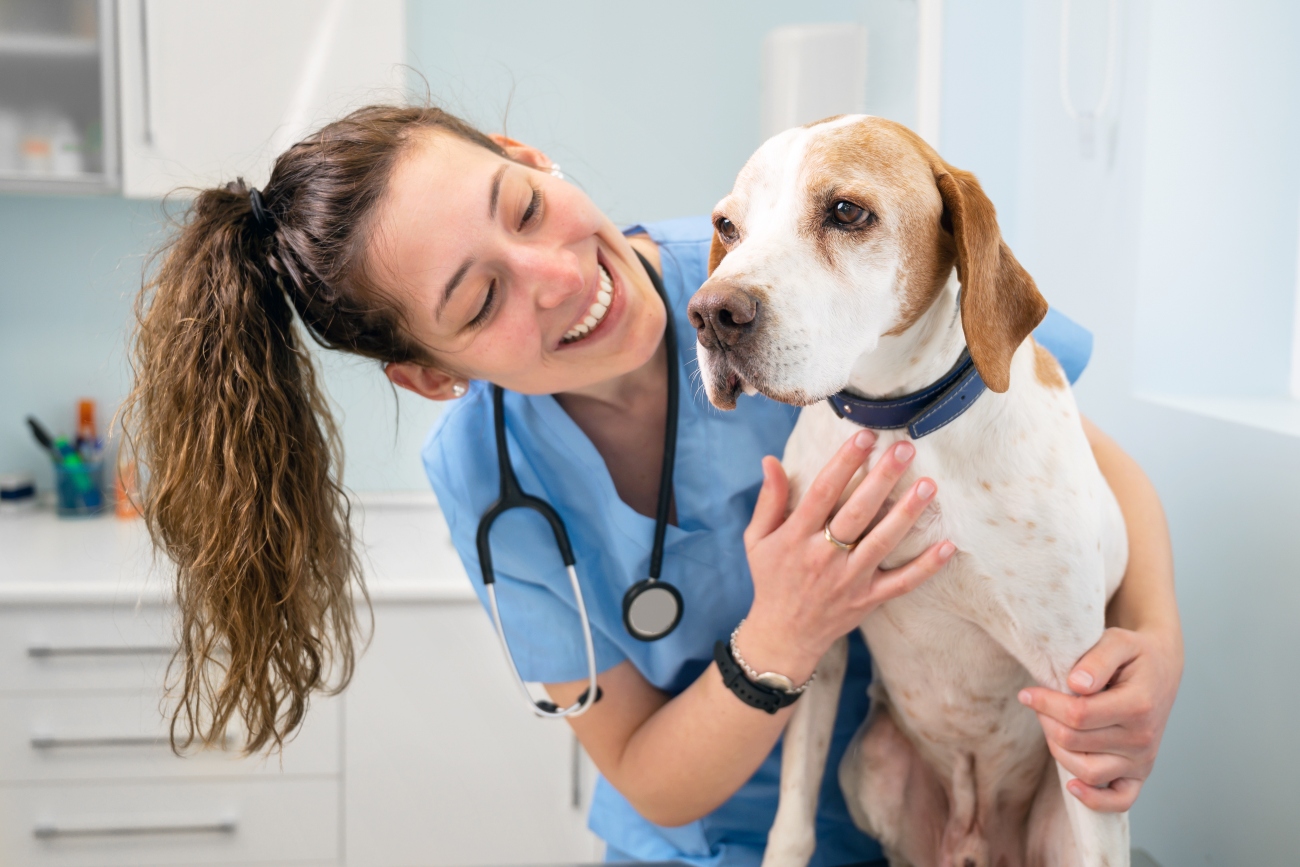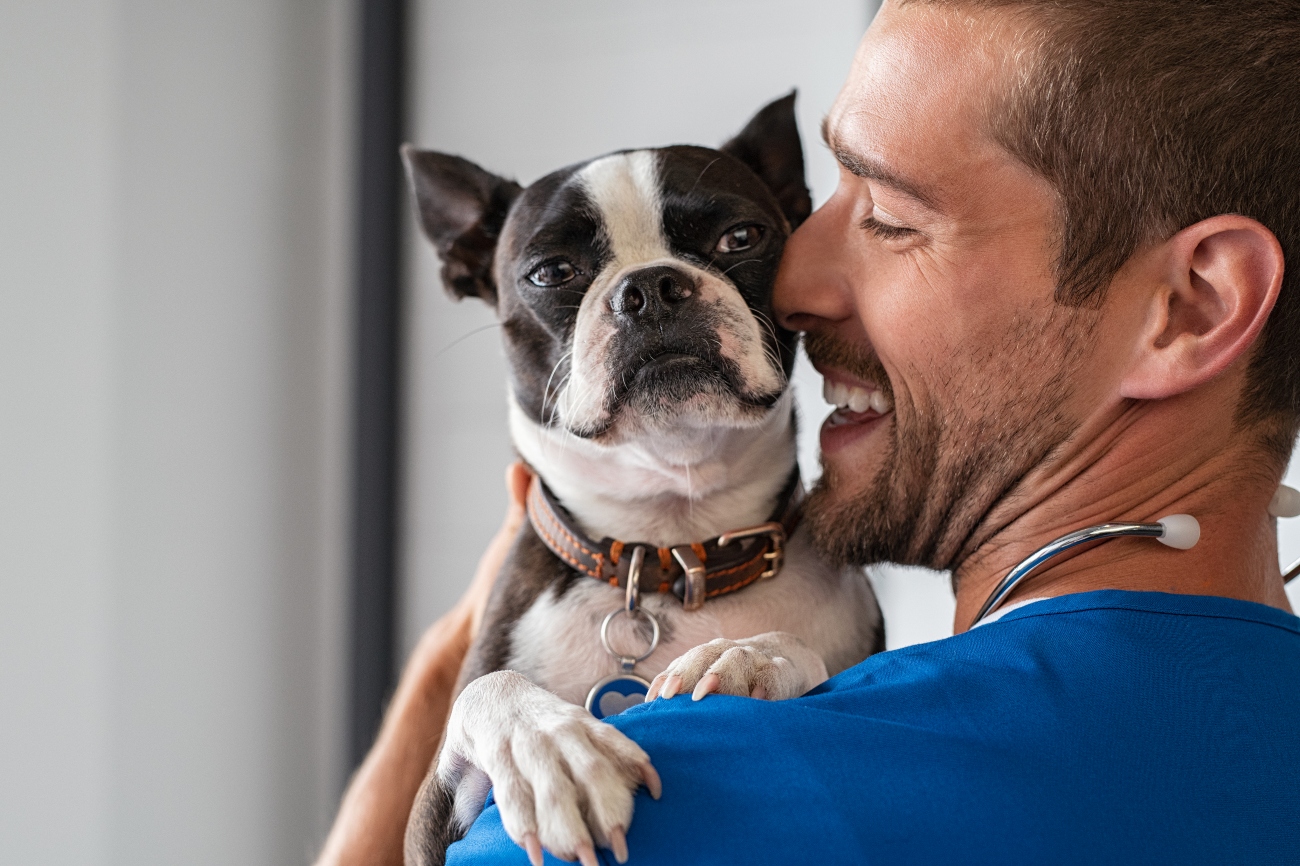How do I know if my dog has pyometra?
18th July, 2023

Canine pyometra can be life-threatening, so spotting the signs early is vital to recovery. Discover what it is, the symptoms and what treatment options are available.
Have you got an unspayed female dog at home? If you thought the procedure was unnecessary, it might be time to reconsider.
Pyometra is just one of the reasons why neutering your pet is so important, with around 1 in 4 unneutered bitches suffering from the condition before they turn 10. When left undiagnosed, the illness can prove fatal, and we know that’s the last thing you want for your beloved dog.
Luckily, pyometra is treatable (usually with surgery as the main treatment option) when you recognise the signs, meaning you can nurse your pet back to good health.
We understand that the thought of surgery for your pet is worrying, but we’re here to help.
Learn how to spot the signs of this life-threatening condition and what causes it in the first place. We’ll also share why you should consider spaying your pet if you haven’t already.
Have you got your canine friend covered for emergencies? Speak to Purely Pets today to get a dog insurance quote for lifetime protection.
What is canine pyometra?
This deadly illness in dogs literally translates to ‘pus in the womb’, and that’s exactly what it is. Pyometra can be divided into 2 types:
- An open form: Pus secretes from the womb into the vagina.
- A closed form: No discharge present and an increase in uterus size with pus build-up. Closed form significantly increases the illness and the mortality rate as it can easily lead to a uterus rupture. In such cases, the pus will flow into the abdomen and will lead to a “septic abdomen” which most of the time is fatal.
As the amount of pus increases, toxins expel into the bloodstream, making your dog extremely ill.
Pyometra is one of the most serious and potentially fatal conditions that affects female dogs in the UK. Thankfully, cases are on the decline because of a better awareness about spaying dogs, but it’s still common across the country.
What causes pyometra in dogs?
There’s no single reason for pyometra in dogs, and the thick build-up of pus can be the result of various underlying factors, including:
- A hormonal imbalance in the womb that causes glands to increase in size and secrete matter that makes for the perfect, bacteria-thriving environment. This is the main and most common reason in older non neutered dogs.
- An infection that enters the uterus from outside the body or that comes from the bloodstream from a different infection site on their body.
- An inflamed, bruised and vulnerable womb after giving birth, which causes an infection to set in.
Whatever the cause, the condition requires urgent care to avoid the uterus rupturing.
How will I know if my dog has pyometra?
Your beloved pet has been a loyal companion ever since it became a part of your family, so, as its pet parent, it’s your responsibility to look out for their health and wellbeing.
Understanding the possible risks to your four-legged friend, like pyometra, means you know the signs to watch for before the condition becomes too serious.
So, what are the pyometra symptoms you need to be aware of?
- Excessively licking private parts
- A thick, brown and smelly discharge from the vulva
- Distended abdomen
- Increased thirst
- Little to no appetite
- Tired and lethargic
- Depression
- Fever
- Grey gums
- Vomiting and diarrhoea
In the early stages of pyometra, your pet might just seem a little ‘off’ and not be eating as well as normal. There may also be no discharge at all – even in the advanced stages – if the condition is a closed form, making it harder for you to know what's wrong.
What can you do to help? As soon as you notice even subtle signs, take your dog to the vet immediately. It’s better to rule out anything serious or spot the condition in its early stages to give your pet a higher chance of recovering.
Remember, if you need quick advice, you can have a vet video consultation if you insure your pet with us. Your dog insurance quote will include unlimited access to this 24-hour service to get help whenever you need it. It is important to note that dog insurance will not cover any pre existing conditions.
How will my vet treat my dog’s pyometra?
First, your vet will need to diagnose pyometra by performing various tests, which could include an ultrasound and blood tests.
Once the condition is confirmed, most females will need surgery to remove the infected womb. To prepare for the operation, your vet may recommend antibiotics, intravenous fluids and pain relief.
Unfortunately, antibiotics alone aren’t usually enough to treat pyometra effectively. If they do work, there’s a big risk of reinfection, so surgical removal is often advised.
A short course of injections may also be effective at eliminating pus from the womb, but it isn’t the most prescribed treatment available.
Caring for your dog after pyometra spaying
Infected womb removal is major surgery, so your female dog will need lots of care and support once she gets home – that’s where you come in.
You’ll need to make sure she’s getting plenty of rest, keeping calm, consuming enough food and water and taking any medicine she’s prescribed.
Your vet will likely recommend a collar or bodysuit to stop her from licking the wound and causing an infection, so keep it on for as long as they suggest.
Is a pyometra spay different from a normal spay?
The operation is basically the same but there are a few variations. With a pyometra spay, your dog’s risk of further infection is higher as the existing fragile tissue could break down during surgery and contaminate the abdominal area.
The costs could also be more to you as the owner if emergency care is needed during the night along with prolonged hospitalisation.
Can I stop my dog from getting pyometra?
Yes. If your dog has been properly spayed, you remove the risk of this life-threatening condition. Although spaying isn’t included as part of your dog insurance policy, it’s an essential part of care all pet parents should budget for.
According to The Blue Cross, the average cost of a normal spay is between £130-£365.
What other benefits are there to spaying my female dog?
The risk of such a deadly condition like pyometra is usually enough to make female dog owners want to spay their pet, but it’s not the only reason you should consider it.
Neutering your canine companion has the following benefits.
Prevents unwanted pregnancies and litters
Perhaps the most obvious reason dog owners neuter bitches is to stop them from getting pregnant.
The thought of a cute, tiny bundle of puppies might seem appealing at first but they can also be time-consuming, expensive and not without risks. If you still want to go ahead, we’ve got tips to successful breeding elsewhere on our site.
Unspayed dogs can also experience phantom pregnancies, causing them to feel and act as though they’re carrying pups and even produce milk. Phantom pregnancies aren’t always serious but you might need vet intervention.
Remember, pregnancy and related medical issues aren’t usually included in your dog insurance policy, so if your pet does fall pregnant and needs care, you’ll need to pay for treatment yourself.
Reduces the risk of other health concerns
In addition to removing the risk of pyometra, spaying also:
- Prevents ovarian and uterine cancer by removing the womb.
- Reduces their chances of developing mammary cancer (or breast cancer).
Despite these advantages, The Kennel Club mentions there may be a higher risk of other health conditions depending on the breed of your dog, so it’s always best to consult with your vet before making the decision to spay.
Don’t forget to get a dog insurance quote and protect your pet before she falls ill. A new policy won’t cover pre-existing conditions and you’ll still need to pay to spay them.
Stops your dog going into heat
From around 6 months old, your dog will go into season, which means she’s ready to mate and can get pregnant.
During this period, your female pup may experience behavioural changes, like the urge to find a mate and mounting items around your home. She’ll also bleed and produce discharge from her vulva – this can be minimal to a considerable amount, depending on your dog.
Spaying means no more going into heat, so no more discharge to clean around your home and on your dog, and no unwanted attention from males wanting to mate.
Do spayed dogs get pyometra?

It’s reassuring to know that most spayed dogs won’t develop pyometra.. However, after surgery, a small stump gets left behind and there’s a very slight chance that spayed dogs can develop an infection there, which is known as stump pyometra.
Your pet still needs ovary hormones for this condition to develop, so how is it possible if your vet also removed the ovaries?
Occasionally, a small piece of the ovarian tissue may get left behind during spaying. If your pet does experience stump pyometra, she’ll need further surgery to remove what was left behind.
Can puppies get pyometra?
Pyometra tends to develop between 4-8 weeks after a dog’s season, so puppies yet to go into heat for the first time are at very low risk.
In fact, the condition is much more common in middle-aged and older unspayed dogs, but it can still develop in younger pups.
Which dog breeds are at higher risk of pyometra?
All unspayed dogs are at risk of pyometra, but some breeds might be at an increased risk, including:
- Rottweiler
- King Charles Spaniel
- Golden Retriever
- Irish Terrier
- Miniature Schnauzer
Of course, not all dogs on this list will suffer from pyometra, but it’s good to know the risks and make an informed decision as to whether spaying is right for your pooch.
How long will my dog live with pyometra?
As soon as your pet gets diagnosed with pyometra, she’ll need emergency treatment. Dogs can’t live long with pyometra and when it goes untreated, they’ll experience suffering, become severely ill and eventually die.
What other reproductive health conditions are common in female dogs?
A major part of your pet parenting role is knowing what risks your dog faces and the tell-tale signs to watch for. Female dogs are predisposed to certain conditions related to their reproductive system, including pyometra.
Let’s take a closer look at some of the reproductive problems, their symptoms and the treatment options for your pet.
Infertility
Unless you want a litter of sweet little puppies, you might not think infertility is that big of an issue, but it’s the underlying causes that you need to be wary of, which include:
- Ovarian cysts
- Ovarian and uterine tumours
- Uterine infections
- Uterine polyps
- Cystic endometrial hyperplasia
- Cushing’s disease
- Hypothyroidism
- Diabetes
- Stress
If you find your unspayed dog isn’t going into season and bleeding, it’s best to get them checked by the vet. They’ll perform a number of tests to see if an underlying cause is to blame and start treatment depending on the results.
Don’t forget to get a dog insurance quote and protect your pet while she’s still healthy. If she falls ill while uninsured, you’ll need to pay for all vet visits and treatment out of your own pocket, which could also restrict the quality of care your loyal friend receives.
Vaginal inflammation
Sometimes called vaginitis, this common condition can pop up at any stage during your female dog’s life but is most prevalent in puppies.
Bacteria is often the cause of the inflammation, but cancers and viruses can also lead to vaginitis. Symptoms include:
- A swollen vulva
- Discharge
- Excessive licking around the vulva
- Peeing more often
- Pain
- Attracting male dogs
In most puppies, the issue will resolve itself after they’ve had their first season, but adult dogs will usually need further treatment to stop it developing into a chronic condition. You can expect your vet to prescribe antibiotics and treatment for any underlying cause.
Vaginal prolapse
When dogs go into heat, their vaginal tissue can swell and protrude, which causes a lot of discomfort for your pet during breeding. Apart from the swelling, you might see your canine:
- Licking the area
- Secreting vaginal discharge
- Not willing to mate
- Struggling to pee
Like pyometra, the issue is much more common in unspayed dogs but can also be down to genetics, a urinary tract infection or birth complications with a previous litter.
Treatment aims to relieve your pup of any discomfort and the possibility of developing an infection.
To lower your canine companion’s risk of vaginal prolapse, you may prefer to get her neutered.
Mastitis
Yet another medical concern that can be eliminated by spaying, mastitis affects nursing mothers.
Just like when humans suffer from the condition, your pet’s mammary gland(s) become inflamed, causing a great deal of pain to your poor pooch every time she feeds her puppies – and nursing a whole litter is a round-the-clock job!
Spotting the issue is crucial to helping your beloved dog feel comfortable again, so check her for:
- Teats that are warm to the touch and feel lumpy
- Bruising around teats
- Not wanting to nurse
- Snapping at puppies who are trying to feed
- Discoloured or bloody milk
- Restlessness
- Whining and crying
- Weight loss
- Lethargy
- Fever
Of course, any new mother with a bundle of pups to care for will seem a little tired, but it’s best to get her checked by the vet whenever you sense she’s uncomfortable.
After performing a few tests to check for mastitis, your vet may prescribe antibiotics and encourage you to apply a warm compress to the affected areas a few times a day.
Phantom pregnancy
Also known as a false or pseudo pregnancy, this reproductive issue causes your pet to feel, look and act pregnant when she’s not actually carrying a litter at all!
You might notice her gaining weight, have a swollen tummy and mammary glands and even produce a little milk. Some dogs also act as though they’ve already given birth and care for your shoes or its favourite toys like it would a newborn litter.
Don’t worry, though, the condition is usually harmless, but it’s definitely worth taking your pooch to the vet for an ultrasound and physical exam to rule out a real litter.
You can read more about phantom pregnancies in dogs elsewhere on our site.
Again, you have the option of spaying your female dog to eliminate the chances of her enduring a pseudo pregnancy.
Why pet insurance is so important for your dog
Your female dog is prone to a host of reproductive health conditions when unspayed. We know you care deeply for your four-legged friend, and she loves you unconditionally no matter what, so getting her neutered is a great start to giving her the care she truly deserves.
But that’s not all – dogs of all breeds, shapes and sizes are at risk of numerous medical issues (just take a look at our A-Z of dog health problems part 1 and part 2).
You want the best for your dog, and with a pet policy in place, you can get your beloved canine the emergency care she needs, when she needs it, at the vet of your choice. We’ll take care of the finances so you can get on with nursing her back to her old self again.
Get a dog insurance quote at Purely Pets today

So, why choose our specialist cover to protect your pet? We believe every dog deserves only the best, so offer 15 levels of lifetime cover ranging from £1,000-£15,000 to make sure you find the right fit for your needs and budget.
Enjoy payments made directly to your vet, access to our 24-hour vet video service with Joii and an online portal for easy policy management.
Protect your pooch with award-winning cover and get a dog insurance quote today.
Helpful Pages
Recent Posts
Pet Insurance Quote
- 98% claims paid *
- Claims paid directly to vets
- 24/7 vet video consultations
- Interest free monthly payments




